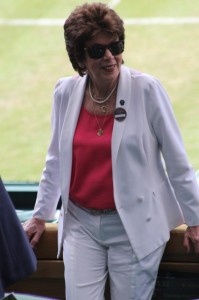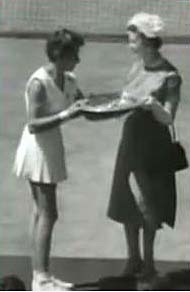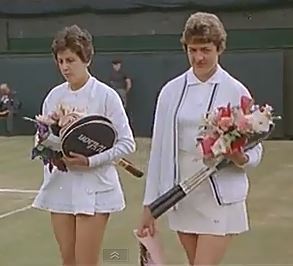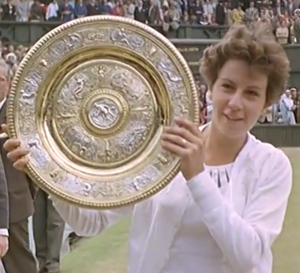Winning two of three Wimbledon crowns on Independence Day…
The 4th of July, American Independence Day, was a special day for Maria Esther Bueno at Wimbledon since she won two of her three Wimbledon singles titles on this date.
In 1959, Maria won the first of her 7 Grand Slam singles crowns on 4 July, beating Darlene Hard, 6-4 6-3, in the final, aged 19.
It was a year in which the first version of the Wimbledon Shop appeared on the grounds selling books and photographs and the All England Lawn Tennis Club made its first proposal to the Lawn Tennis Association to make the Championships ‘open to all’.
The motion narrowly failed the following year and it wasn’t until 1968 that the game formally became open to both amateurs and professionals.
Had the motion passed, Maria Esther would have been among the first to benefit from pro tennis.
That year, 1959, Maria lost sets in her second and third round matches, but did not drop another in her last four appearances as her game seemed to improve every time she stepped on court.
In the final, seeded sixth in the ladies singles, she halted the fourth-seeded American in straight sets to win her first major singles crown.
“For a person who came alone from Brazil, where there wasn’t a single grass court, getting here and succeeding was wonderful,” Maria said, in an interview with reporter Bruno Côrtes in 2009. “The feeling I had was that I was not even there, that it was someone else playing.
“When he (the umpire) called game, set, match and championship, I started to realise the immensity of what had happened. I cried a lot. I don’t know if it was relief, or worry…”
It was also the 4th July when Maria won her third Wimbledon singles title, with a 6-4 7-9 6-3 win over Margaret Smith (Court) of Australia in a final that many believed to be one of the classic matches of all time.
Winning the title again in 1960, against South Africa’s Sandra Reynolds, was also a personal triumph for her because she was almost always in bad health and there had even been some talk that she might not compete again.
On her return after her bout with hepatitis, many thought she would not have the stamina to win another major, but she was to prove them all wrong.
It was 1964, the same year a huge Order of Play and Results board was introduced over the tunnel entrance to the stands between No 2 and 3 courts, and new entrances provided for entry to the standing room areas on the Centre Court.
For the first time, a military band was engaged from noon onwards to entertain early arrivals to the Centre Court for both finals days, a tradition that Maria Esther loved and, latterly, she would always be found in the Members Stand listening to the music ahead of the two Championship matches.
Bueno and Smith were the preeminent players of that era, and they took the women’s game into another realm, a slower but in many ways more captivating type of serve-and-volley tennis than that of the men, and their matches were not to be missed.
Not yet twenty-two, Smith already had nine major singles titles in her possession and was a superb athlete.
Standing nearly six feet tall, and statuesque, she covered the court swiftly and blanketed the net, making the stretch volley with regular and unprecedented success, showing her opponents how tough it was to drive the ball past her.
“It really was tough to pass her,” Maria would recall. “She had such a wide wing-span…”
As the eloquent David Gray wrote in The Guardian at the time: “Miss Bueno was scoring points with capricious ease.
“The Brazilian spent points as wastefully as ever, but in the crisis of the match she invariably found it possible to produce luxurious quantities of shots which were rich and imaginative, graceful and deadly.
“She was the more effective server, she did not miss a smash and, in the recollections of even the oldest members, no woman has hit so many beautiful and piercing forehand volleys.
“She stirred the Centre Court as she did in the first dazzling days of her royalty.”
The 4th July was indeed a very special day for Maria.




